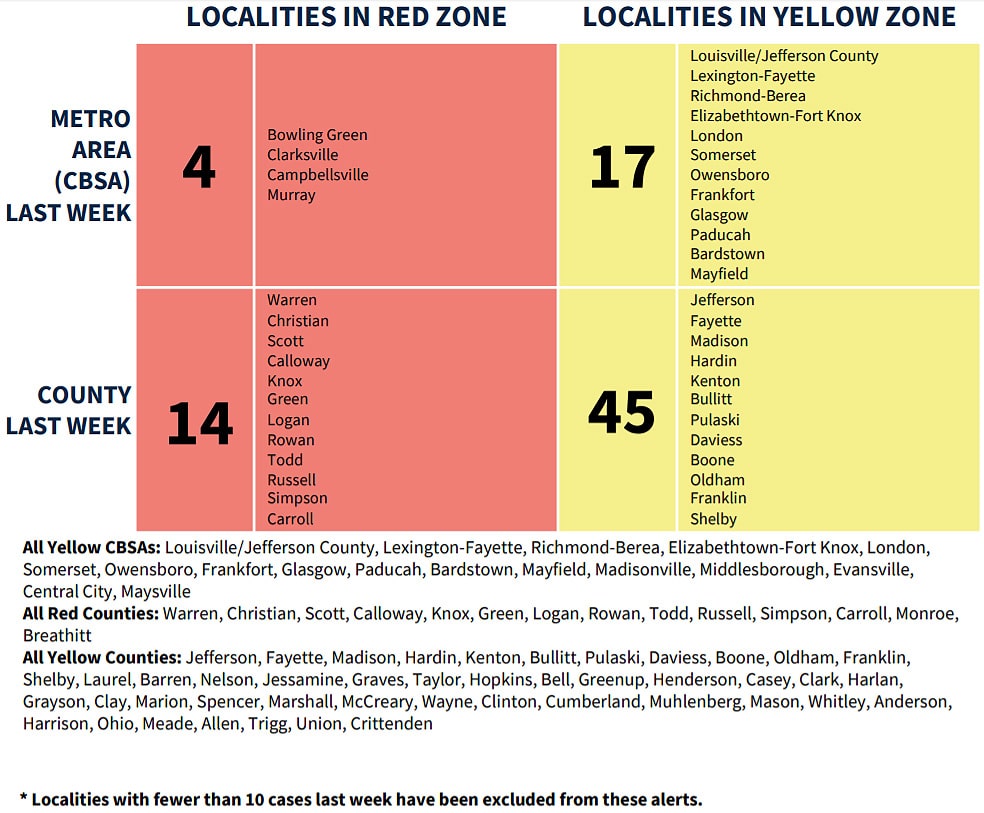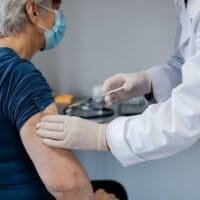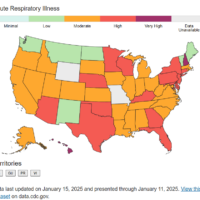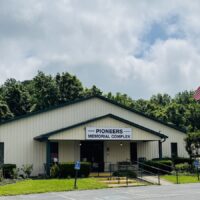Fifty-nine of Kentucky’s 120 counties are in danger zones for the federal coronavirus reporting week of Aug. 22-28, an increase of seven from last week. Gov. Andy Beshear named them all in his Monday briefing, then said, “I think maybe we’ve been taking a nap the last couple of weeks. Let’s make sure we wake up and start doing the things it takes to defeat this virus.”
Beshear and his health subordinates also announced new rules for child-care centers and took strong issue with a new presidential adviser’s idea that the nation should seek “herd immunity” from the virus and what they said were misrepresentations of Centers for Disease Control and Prevention figures.
The numbers: Beshear reported 381 new cases, a typically low number for a Monday, but one that two months ago would have been high for any day of the week. The good news was that the share of Kentuckians testing positive for the virus fell to 4.42%, the lowest in more than a month. Seven of the last eight days have seen a rate below 5%, a key threshold in suppressing the virus.
“While our positivity rate is going down, we have more people than ever … coming down with COVID, almost 10 percent of which end up hospitalized and, sadly, 2% of which right now lose their lives,” the governor said. “Let’s remember how serious this is and let’s not act like everything is normal during a worldwide health pandemic.”
Of the 59 counties listed in the weekly White House Coronavirus Task Force report, 14 were in its “red zone” for places where new cases of the virus numbered more than one per 1,000 residents and the share of residents who tested positive during the week was over 10%.
The report put 45 counties in the yellow zone, up from 36 last week. This zone is for counties with 0.1 to 1 case per 1,000 and a positive test rate between 5% and 10% in the reporting week, or those with one of those metrics in yellow and the other in red.
The seven-day rolling average of new cases is now 660, the fourth highest of the pandemic. It has increased every day but one for 10 days, from 584 on Aug. 20.
Among Monday’s new cases, 43 are in Kentuckians 18 and younger. Of those, two were children five or younger, with the youngest a one-year-old from Madison County.
Beshear again urged Kentuckians to follow the rules and honor the 10-person limit for social gatherings as the state nears the Kentucky Derby on Saturday and Labor Day on Monday. “If we say, ‘Oh, it’s my right to have a huge party in my backyard,’ you’re playing Russian Roulette, but not with your own life, with somebody else’s, probably someone else that you don’t know,” he said. “And if enough people do it, it means somebody loses that game. Remember, we’re living for each other.”
Child care: Beshear and Eric Friedlander, secretary of the Cabinet for Health and Family Services, announced long-anticipated new rules for child care.
Beshear said the changes are necessary as a form of “harm reduction” because different groups, such as catering companies with large and unused indoor spaces, have been opening nontraditional learning programs.
The new rule allows 15 children in a class, up from 10, and allows centers to give limited tours to prospective clients. Friedlander noted that the positivity rate is declining and centers have become accustomed to limits.
The rule allows accelerated certification and licensure to child-care centers in homes, as well as a $2,500 startup incentive to encourage them to get licensed. Friedlander said he hopes groups that have opened or may open centers to help children with online learning will take advantage of the new incentive to get legal. He said “learning pods” led by parents who don’t charge fees are not included, but “If they are operating illegally, we are going to ask them to stop.”
The rules also allows licensed infant and one-year-old classrooms to return to typical group size and will aid background checks on nontraditional instruction spaces as well as offering them safety guidance.
The changes come after child-care operators and legislators have asked Beshear to lift the restrictions he imposed months ago, citing a shortage of child care. Bradley Stevenson of the Child Care Council of Kentucky, said at the Aug. 26 meeting of the Interim Joint Committee on Health, Welfare and Family Services that 276 providers, or 43% of the total in a recent survey, said they would have to close if size restrictions were not removed.
Fighting some feds: Beshear and Health Commissioner Steven Stack had strong words when asked about a Washington Post story reporting that President Trump’s new health adviser, Scott Atlas, is urging him to embrace a “herd immunity” strategy to combat the pandemic, according to five people familiar with the discussions. To achieve herd immunity, the virus would be allowed to spread to allow the population to build up collective resistance to it.
“That is incredibly reckless; we’d lose over a million people. I’m absolutely against it. We should not be that callous,” Beshear said as Stack made his way to the lectern.
Stack said, “That assertion that herd immunity is a viable way to go [is] not just reckless, it’s irresponsible. It’s a failure of leadership. It’s the kind of language that shouldn’t be coming out of a serious, educated professional in that role at the national level.”
After the story was published, Atlas sent the Post this statement: “There is no policy of the president or this administration of achieving herd immunity. There never has been any such policy recommended to the president or to anyone else from me.” The Post added, “At an event Monday in Florida with Gov. Ron DeSantis (R), Atlas falsely said The Washington Post never asked him for a comment.”
Stack walked through the math of herd immunity in terms of the death toll, concluding that the approach would result in the deaths of 1.6 to 2.3 million people nationwide, depending on whether the death rate was figured at 0.7% or 1%. Kentucky’s current death rate is 2%, but most fatalities are residents of long-term-care facilities.
Stack also pointed out that smallpox and polio “ran rampant” for many years without creating herd immunity, “so anyone who’s advocating herd immunity who is in a position of leadership probably should not be in that position of leadership.”
Stack was then asked whether health officials overstate the number deaths from COVID-19, a question perhaps prompted by social-media reaction to a weekend post on the CDC website saying that “for 6% of the deaths, COVID-19 was the only cause mentioned.”
Stack said that fact has been misrepresented because death certificates list a primary cause of death and contributing causes. He said health officials have always said COVID-19 is a disease that attacks older people and those with underlying health conditions.
He noted that 35% of Kentuckians are obese, that one in seven Kentucky adults have diabetes, and one in nine are pre-diabetic. “If you add it all up, you should take no solace that only 6% of people on a death certificate only have COVID-19 because the vast majority of people have some co-morbid condition,” he said. “But even in that I don’t think we’re overstating these numbers. . . . We try to scrub that data to make sure we remove anything that is incorrectly attributed.”
Beshear said, “I know we all want to get back to our normal lives, but not believing we have a worldwide health pandemic when 183,000 Americans have died? I mean, what, how many do you need to actually believe it’s happening? I would certainly hope 183,000 is enough. The fact that we have politicize something that is killing us, that is hurting us is just an absolute shame.”
Earlier in the day, the Lexington-Fayette County Health Department, also issued a statement to address any confusion: “The CDC did not change data to say only 6% of the listed deaths were from COVID-19; instead, the data shows that 6% of COVID-19 deaths were in people without pre-existing or underlying health conditions. We have consistently said that people with highest-risk of complications, including death, from COVID-19 are people with underlying health conditions, including heart and lung disease, cancer and diabetes.”
Drugs: Beshear opened the briefing by marking International Overdose Awareness Day, noting that public-health officials have said that since the start of the pandemic they are seeing the largest number of overdose deaths since 2017.
Beshear encouraged Kentuckians to look out for each other. “COVID doesn’t make this any easier, it makes it harder,” he said. “It makes it harder on us mentally and emotionally, which can fuel more addiction. It makes it harder for us to be there and to know when someone is suffering from an addiction. It may make it harder to get to them when we need to. So please, keep up all your efforts, redouble them if we have to. It is about saving lives.”
Kentuckians struggling with substance use disorders can call the KY Help Call Center at 833-859-4357, which provides information on treatment options and open slots among treatment providers, or use an online website that provides similar services called FindHelpNowKY.org.
In other COVID-19 news Monday:
- Beshear reported three more deaths from the disease, bringing the state’s death toll to 933. The fatalities were a 61-year-old man from Lincoln County; a 72-year-old woman from Martin County; and a 65-year-old man from Owen County.
- The state’s daily report shows 557 people are hospitalized in Kentucky with COVID-19 and 144 of those are in intensive care. Beshear did not report the number on ventilators.
- Counties with 10 or more new cases were Jefferson, 111; Fayette, 39; Madison and Warren, 21; Pulaski, 20; and Calloway, 17.
- In long-term care, eight new residents and 12 new staff have tested positive for the virus and 607 residents and 343 staff have active cases of it. Ten more resident deaths can be attributed to COVID-19, Beshear said.
- The daily K-12 school report shows 14 new students and three new staff tested positive for the virus and 159 students and 61 staff have active cases. This report has been updated with data for individual schools.
- The daily college and university report shows seven new student and no new staff cases and 582 students and 16 staff with active cases.
- “Kentucky’s students and staff should wear masks at all times while they are in school, even if they are at least 6 feet apart, according to updated #HealthyAtSchool guidance” from the state. Billy Kobin reports for the Louisville Courier Journal.
- The governor’s travel advisory, asking people to avoid traveling to state’s with positive-test rates of 15% or higher and to self-quarantine if they do, now applies to South Dakota, Iowa, Nevada, North Dakota and Alabama.
- The Lexington Herald-Leader is hosting “Lexington’s Learning Curve: Navigating Education Access in a Pandemic,” an online conversation about how to safely educate Kentucky students during the pandemic, The seven panelists, who include Beshear, “will help us understand how we can keep our students safe and on track academically, athletically, emotionally as we also focus on keeping them safe in K-12 schools and our colleges and universities,” the newspaper says. The event will be held Tuesday, Sept. 1 at 12:30 p.m. ET. RSVP here and to see the list of panelists.
- The infection rate among health-care workers in Louisville has tripled since May, mirroring a boost in positive cases seen in the general population in July, according to researchers tracking it, report the CJ’s Grace Schneider and Deborah Yetter. In its latest round, the University of Louisville Co-Immunity Project tested about 1,100 health-care workers for both the live virus and antibodies, which indicate past exposure. The active infection rate was 0.45%, up from 0.14% found in 1,372 workers in April and May. About 2.2% had antibodies, compared with 1% in April, they had a lower infection rate than the general Louisville population: 2.2% and 9.2% respectively. The researchers also found that 78.5% of those who had antibodies in the first round maintained a high level of antibodies.
- In a 12-state study, many novel-coronavirus infections in health-care personnel who routinely cared for COVID-19 patients went undetected. Among the 6% with antibody evidence of infection; 29% were asymptomatic, and 69% had not been diagnosed with infection. Antibodies were less common among the 6% who said they always wore a face covering while caring for patients, according to research published in the Centers for Disease Control and Prevention‘s Morbidity and Mortality Weekly Report. The researchers conclude, “Universal use of face coverings and lowering clinical thresholds for testing could be important strategies for reducing hospital transmission.”
- Kentuckians who have general questions about COVID-19, such as symptoms, treatment or tests, can call the Kentucky Poison Control Center at 800-722-5725. The state’s official COVID-19 site is at kycovid19.ky.gov.
Al Cross is professor emeritus of journalism at the University of Kentucky. He was the longest-serving political writer for the Louisville Courier Journal (1989-2004) and national president of the Society of Professional Journalists in 2001-02. He joined the Kentucky Journalism Hall of Fame in 2010. The NKyTribune is the home for his commentary which is also offered to other publications.







